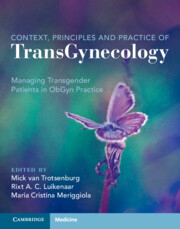Book contents
- Context, Principles, and Practice of Transgynecology
- Context, Principles, and Practice of Transgynecology
- Copyright page
- Dedication
- Contents
- Foreword
- Preface
- Contributors
- Abbreviations
- Section A Contextual Transgynecology
- Chapter 1 Terminology in Transgender Medicine
- Chapter 2 Optimizing Clinical Ob/Gyn Services through Improved Communication with Trans Persons
- Chapter 3 What Do Trans People Expect from Transition and What Do They Encounter Physically?
- Chapter 4 A Pondering Trans Female Gynecologist
- Chapter 5 The Ever-changing Role of the Mental Health Care Professional in Transgender Healthcare
- Chapter 6 Impact of Stigma and Resilience on the Health of Transgender and Nonbinary People
- Chapter 7 Dealing with Health Needs and Physical Complaints of Nonbinary Clients
- Chapter 8 Gender is So Much More: Impulses for a Gender-variant Gynecological Expertise from a Queer-theoretical Perspective
- Section B Practicing Transgynecology
- Section C Gynecological Surgery for Transgender Males
- Section D Sexuality and Contraception
- Section E Fertility and Reproduction
- Section F Impact of Gender-affirming Hormonal Therapy on Genital Organs
- Section G Screening and Prophylaxis
- Transgynecology Index
- References
Chapter 5 - The Ever-changing Role of the Mental Health Care Professional in Transgender Healthcare
from Section A - Contextual Transgynecology
Published online by Cambridge University Press: 22 December 2022
- Context, Principles, and Practice of Transgynecology
- Context, Principles, and Practice of Transgynecology
- Copyright page
- Dedication
- Contents
- Foreword
- Preface
- Contributors
- Abbreviations
- Section A Contextual Transgynecology
- Chapter 1 Terminology in Transgender Medicine
- Chapter 2 Optimizing Clinical Ob/Gyn Services through Improved Communication with Trans Persons
- Chapter 3 What Do Trans People Expect from Transition and What Do They Encounter Physically?
- Chapter 4 A Pondering Trans Female Gynecologist
- Chapter 5 The Ever-changing Role of the Mental Health Care Professional in Transgender Healthcare
- Chapter 6 Impact of Stigma and Resilience on the Health of Transgender and Nonbinary People
- Chapter 7 Dealing with Health Needs and Physical Complaints of Nonbinary Clients
- Chapter 8 Gender is So Much More: Impulses for a Gender-variant Gynecological Expertise from a Queer-theoretical Perspective
- Section B Practicing Transgynecology
- Section C Gynecological Surgery for Transgender Males
- Section D Sexuality and Contraception
- Section E Fertility and Reproduction
- Section F Impact of Gender-affirming Hormonal Therapy on Genital Organs
- Section G Screening and Prophylaxis
- Transgynecology Index
- References
Summary
This chapter critically illuminates the role, tasks, and challenges of mental health professionals (MHPs) in transgender care and cites relevant literature. Various models of professional–client relationships are presented. Realistic and unrealistic expectations of somatic-oriented professionals about the diagnostic and preparatory process by MHPs are discussed in detail and a critical appraisal of referral letters is included. Also, meaning and necessity of cooperation between MHPs and somatic-oriented medical healthcare professionals are emphasized.
- Type
- Chapter
- Information
- Context, Principles and Practice of TransGynecologyManaging Transgender Patients in ObGyn Practice, pp. 32 - 38Publisher: Cambridge University PressPrint publication year: 2022



